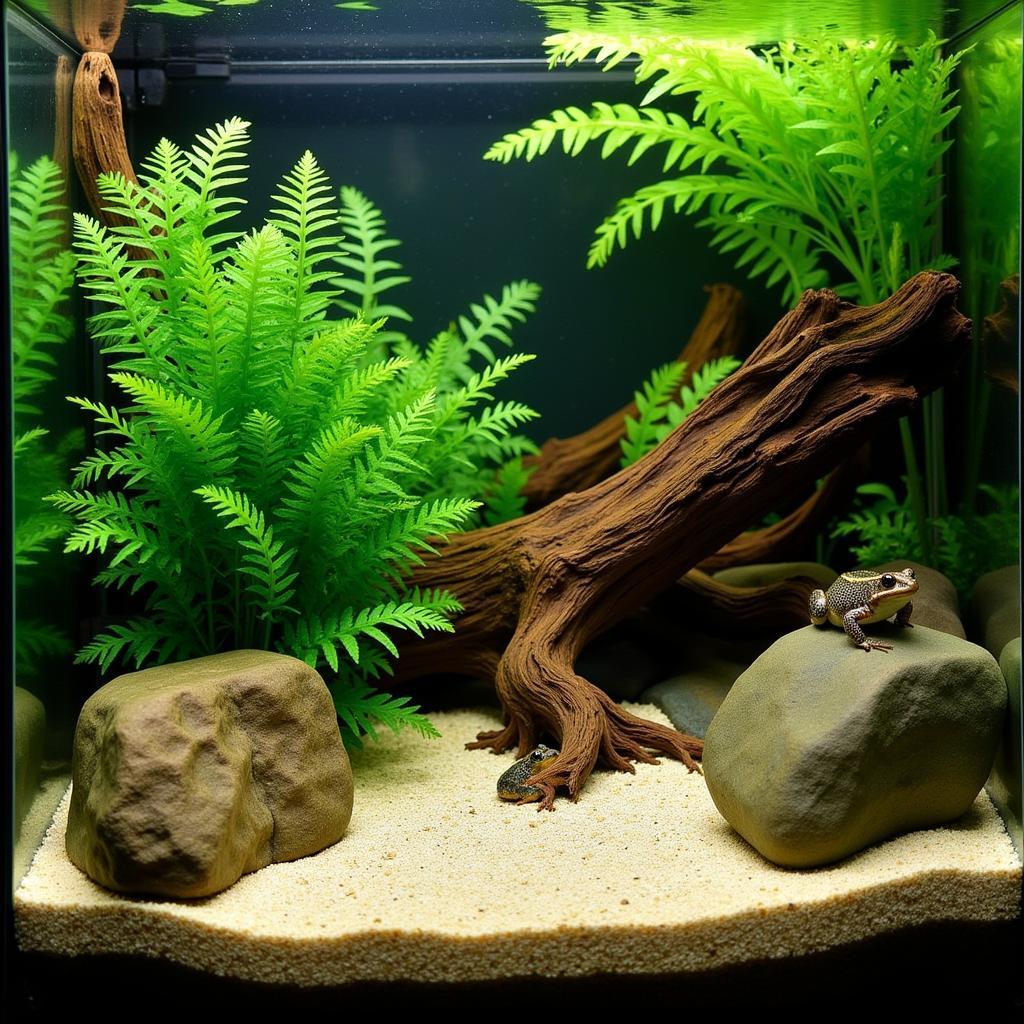The Complete African Dwarf Frog Care Sheet
African dwarf frogs, also known as ADFs, are captivating little creatures that have become increasingly popular in the world of aquariums. These tiny amphibians are native to the slow-moving, warm waters of Sub-Saharan Africa, particularly in countries like Nigeria and Cameroon. While they may be small, typically only growing to about 2.5 inches in length, their playful antics and relatively simple care requirements make them an excellent choice for both beginner and experienced aquarium enthusiasts. This comprehensive care guide will equip you with all the knowledge you need to provide a thriving environment for your new aquatic companions.
Setting Up Your African Dwarf Frog Habitat
Providing a comfortable and stimulating environment is crucial for the well-being of your African dwarf frogs. Here’s a step-by-step guide to setting up the perfect habitat:
- Choose the right tank size. While ADFs are small, they are active swimmers and need ample space to move around. A 5-gallon tank is the absolute minimum for a small group of 2-3 frogs, but a 10-gallon tank or larger is highly recommended to provide ample swimming space and allow for the addition of plants and decorations.
- Select a suitable substrate. African dwarf frogs prefer a soft, smooth substrate that won’t irritate their sensitive skin. Fine sand or smooth gravel is ideal, while sharp gravel or large rocks should be avoided as they can cause injuries.
- Add live plants and decorations. Live plants not only enhance the aesthetic appeal of your aquarium but also provide your frogs with essential hiding spots and a sense of security. Choose aquatic plants like Java fern, Anubias, or Amazon swords, as these are hardy and tolerate the warm water conditions that ADFs prefer. You can also incorporate caves, rocks, and driftwood to create a more natural and stimulating environment.
 Ideal African Dwarf Frog Aquarium Setup
Ideal African Dwarf Frog Aquarium Setup - Install a filter and heater. A gentle filter is essential for maintaining water quality and removing waste products. Choose a sponge filter or an adjustable filter with a low flow rate to prevent creating strong currents that can stress your frogs. African dwarf frogs thrive in temperatures between 78-82°F (25-28°C). A reliable aquarium heater with an adjustable thermostat is crucial for maintaining this temperature range.
- Cycle your tank. Before introducing your frogs to their new home, it’s crucial to cycle the aquarium. This process establishes beneficial bacteria that break down harmful ammonia and nitrites produced by fish waste. Cycling typically takes 4-6 weeks and involves regularly testing water parameters and performing water changes to maintain safe levels.
Feeding Your African Dwarf Frogs
African dwarf frogs are carnivorous and require a diet rich in protein. Their feeding habits can be a bit tricky, as they rely on their sense of smell and touch to locate food at the bottom of the tank. Here’s what you need to know about feeding your ADFs:
- Choose sinking food. Avoid flake food, as it floats on the surface and is inaccessible to your bottom-dwelling frogs. Sinking pellets or tablets specifically designed for African dwarf frogs are readily available at pet stores and provide a balanced diet.
- Offer a variety. Supplement their diet with live or frozen foods like bloodworms, brine shrimp, and daphnia. These treats provide additional nutrients and enrichment.
- Feed in moderation. Overfeeding can lead to water quality issues. Offer only as much food as your frogs can consume within 2-3 minutes, 2-3 times per week. Remove any uneaten food promptly to prevent it from decaying and polluting the water.
Water Quality and Maintenance
Maintaining pristine water conditions is essential for the health of your African dwarf frogs. Follow these guidelines to ensure optimal water quality:
- Perform regular water changes. Change 25% of the tank water every 1-2 weeks using a siphon or gravel vacuum to remove waste and debris from the substrate. Use a dechlorinator to remove harmful chlorine and chloramines from tap water before adding it to the tank.
- Monitor water parameters. Invest in a reliable water testing kit to measure ammonia, nitrite, nitrate, and pH levels. The ideal parameters for African dwarf frogs are:
- Ammonia: 0 ppm
- Nitrite: 0 ppm
- Nitrate: < 20 ppm
- pH: 6.5-7.5
- Avoid overcrowding. Too many frogs in a small tank can lead to stress, disease, and water quality issues. Stick to the recommended stocking density of 1 gallon of water per frog.
Common Health Concerns
African dwarf frogs are relatively hardy creatures but can be susceptible to certain health problems. Here are some common issues to be aware of:
- Bloat: Bloat is a serious condition that can be caused by bacterial infections, parasites, or constipation. Signs include swelling in the abdomen, lethargy, and loss of appetite.
- Red leg syndrome: This bacterial infection causes redness and inflammation in the frog’s legs and abdomen.
- Fungus: Fuzzy, white patches on the skin can indicate a fungal infection.
If you notice any signs of illness, consult a veterinarian experienced in treating amphibians.
“It’s always better to be proactive when it comes to your frog’s health,” advises Dr. Amina Kenyatta, a renowned aquatic veterinarian based in Nairobi. “Regular water changes, a balanced diet, and careful observation are key to preventing many common health problems.”
Breeding African Dwarf Frogs
Breeding African dwarf frogs in captivity can be challenging but rewarding. It requires specific water parameters and environmental cues to induce breeding behavior.
- Triggering Breeding: Lowering the water level slightly and then performing a large water change with cooler water can mimic the rainy season in their natural habitat and encourage breeding.
- Egg Laying and Care: Female frogs lay hundreds of tiny eggs, often attaching them to plants or other surfaces. Once the eggs are laid, it’s best to remove the parent frogs to prevent them from eating the eggs.
- Tadpole Development: The eggs will hatch into tadpoles within a few days. The tadpoles will require a separate rearing tank with similar water parameters to the adult tank. Feed them infusoria or commercially available tadpole food.
Conclusion
African dwarf frogs are fascinating and low-maintenance pets that can bring joy to aquarists of all levels. By following this comprehensive care sheet, you can provide your new amphibious friends with a thriving environment where they can live long, healthy, and happy lives. Remember, a little attention to detail goes a long way in ensuring the well-being of these captivating creatures.
For any further assistance or inquiries, please don’t hesitate to contact us. Call us at +255768904061, email us at kaka.mag@gmail.com, or visit us at Mbarali DC Mawindi, Kangaga, Tanzania. Our dedicated customer support team is available 24/7 to assist you.


